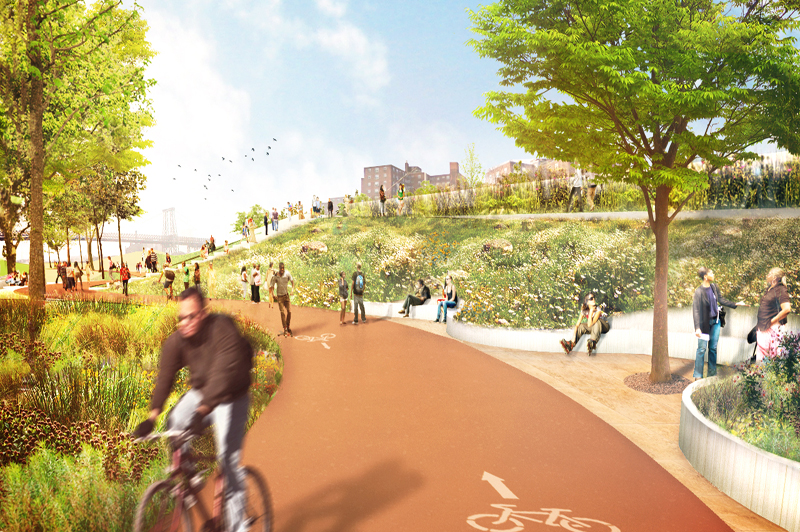
 Office of Climate and Environmental Justice311
Office of Climate and Environmental Justice311 Search all NYC.gov websites
Search all NYC.gov websites
Parks & Public Spaces

Released in October 2014, NYC Parks: Framework for an Equitable Future set forth a strategy to invest capital, programming, and maintenance resources in parks where the need is greatest. This data-driven, equity-based approach identifies parks that have received little capital investment and are located in areas of high need, based on higher-than-average poverty, density, and recent population growth, to ensure investment in projects that will produce the most benefits for New Yorkers.
Through the Community Parks Initiative, New York City Department of Parks and Recreation (NYC Parks) has already launched major capital investments in 35 small parks with the input of local residents. The City will expand the Initiative to include additional sites, with the goal of impacting more than three million New Yorkers across 24 community districts, focused on low-income, growing, and high-density neighborhoods. To expand NYC Parks’ ability to prioritize essential capital projects across the park system for repair and strategic investment, a new capital needs assessment will be developed to generate information about asset conditions and capital needs.
Improve open spaces through Parks Without Borders, a new strategy to enhance neighborhood access and connectivity. Parks Without Borders is a new effort to make our city’s outdoor spaces more welcoming, accessible, and better connected to surrounding neighborhoods. The quality of a city’s outdoor space depends on an integrated system in which parks, sidewalks, pedestrian plazas, and other open spaces are connected to each other, improving access to neighborhood resources and promoting community interaction.
To make Parks Without Borders a reality, NYC Parks will take a new approach to park entrances and boundaries where they most directly interact with the surrounding community. NYC Parks will improve fences and gates and add other amenities, such as public art and landscaping, to make entrances more inviting. Along park boundaries, we will identify opportunities to remove or reduce fencing and barrier vegetation in order to make the natural beauty of parks more visible from their neighborhoods.
As part of Parks Without Borders, NYC Parks, in cooperation with the Department of Transportation and other agencies, will also find new ways to bring the beauty of the park into the community by greening key intersections and entrances, and by identifying new opportunities to activate underused public spaces with temporary art and programming. We will also look for opportunities to extend park amenities to adjacent sidewalks and pedestrian plazas. Parks Without Borders is a key strategy to help ensure the livability of neighborhoods and the strength of our communities.
Expand the use of our streets as places to play, congregate, and be together. To better serve our neighborhoods, the City will continue to work with communities and other partners to convert underused streets into pedestrian plazas and explore ways to transform underused areas below elevated roads and train lines to more attractive and inviting public spaces. Programs like Weekend Walks, Play Streets, and Summer Streets will continue to provide more opportunities for New Yorkers of all ages to get outdoors and into the public realm.
Create beautiful and well-tended streets in neighborhoods across the city. To further improve our streets and sidewalks, we will invest in new street trees and other plantings, benches, way-finding signs, and other amenities. We will focus on rezoned and growing neighborhoods. As part of our street safety and affordable housing initiatives, the City will also invest in streetscape improvements on major corridors, such as landscaped medians, to improve pedestrian safety and the urban environment. Two new City programs will bring technical assistance and other resources to improve plaza maintenance and the condition of planted medians in low-to-moderate income or otherwise under-resourced communities. Green the city’s streets, parks, and open spaces. To protect, maintain, and enhance the city’s green canopy, NYC Parks will continue to plant new trees in parks and neighborhoods citywide. Greening the public realm brings new beauty to our parks and neighborhoods, sustains ecological diversity, and adds permeable areas that enhance storm-water management. These natural systems provide valuable environmental benefits to all residents, including passive indoor and outdoor cooling; cleaning of air, water, and soil; and improved resiliency to natural events and climate change—true public health and quality-of-life benefits.
The City will be guided in these efforts by a number of research initiatives designed to ensure a better understanding of ecosystems, natural resources, and how they benefit New Yorkers and improve air and water quality. Research initiatives include an update to the City’s state-of-the-art street tree census and an ecological and social assessment of the city’s natural areas, conducted in partnership with the Natural Areas Conservancy.
The City will also use LiDAR technology—land cover mapping based on aerial remote imaging. LiDAR technology helps inform policy decisions among different agencies and policy areas. For instance, past LiDAR data has been used by the City to assess ecosystem decline and prioritize tree planting and forest restoration; impervious surface cover for green infrastructure planning; the solar energy potential of rooftops; and coastal flood hazards. The landscape of the city has changed since we last used LiDAR data in 2010 due to natural forces and human interventions, and new data will help to inform our understanding of and investment in the City’s resiliency and sustainability. The City is currently working to secure 2013 LiDAR data from the federal government.

